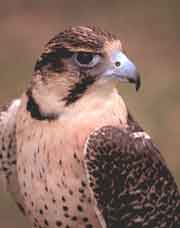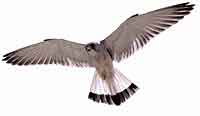 By
Michelle and Peter Wright By
Michelle and Peter Wright
Age 14, US Grade 8, UK Keystage 3
All life on earth has evolved to
adapt in some manner to the seasonal changes in climate that are experienced
everywhere except in the tropics. But what does an animal do when it becomes
just too hot or too cold for it to survive? There is only one answer really
and that is to move. This movement of animals from one area to another
is called a migration. Some animals migrate vast distances between continents,
and others might need only to move a few kilometers to find the conditions
they need to survive.
Migrations are not always brought about as a result of extreme temperature
variations, many animals move to find food, while others migrate to find
the optimum conditions for them to breed.
Arabia has many examples of migrations. The local inhabitants have noticed
the pattern of these migrations over thousands of years and have used this
knowledge to enable them to survive.
The grass eating animals in the deserts of Arabia have always needed to
migrate from one area to other and do so after the rains. Because the desert
is so dry, some years rain may fall on only small patches of the desert.
Animals such as gazelle therefore need to travel long distances when this
happens so they can find the areas where the grass is plentiful. Sir Wilfred
Thesiger, in his famous book Arabian Sands, describes how the bedouin would
follow the Arabian oryx on their migration so that they too could find
grazing for their camels and goats.
This great cycle of nature has gone unchanged for thousands and thousands
of years, but as it is dependent upon so many factors it is sensitive to
disturbance. The animals are also very vulnerable on their migration, as
they expend much energy to reach their goal. Man should regard himself
as the proud custodian of these great wonders of our natural world and
should try his best not to disturb this delicate balance.
 Butterfly
Migration Butterfly
Migration
Kevin Thompson, an entomologist at Arabia�s Wildlife Centre,
gives us an insight to the magic moves of butterflies.
Many animals around the world migrate at certain times of the year and
insects, such as butterflies, are no exception. The plain tiger butterfly
Danaus chrysippus, one of the better-known butterflies in the region, is
a good example of an Arabian migratory insect.
The plain tiger is highly visible at times when conditions are favourable,
usually from early spring to summer. As summer progresses their numbers
decrease drastically, but by the next spring the plain tigers are back
again in full force. Can they really reproduce that quickly and efficiently?
One of the reasons for the �sudden� appearance of this butterfly is that
it moves from place to place (in search of food) in groups. These butterflies
stop to feed in any areas where nectar-producing plants are found, usually
after rain. They also stop to lay eggs on specific plants that are suitable
for their larvae to feed upon after they hatch. These food plants are from
the milkweed family, Ascelpidaceae, the most common of which is the sodom�s
apple, Calotropis procera. As long as food is available, the butterflies
will remain.
There are enough zones with differing climates in the Arabian Peninsula
to ensure that the plain tiger population can be sustained throughout the
year in one area or another. So, when there is rain next in your area,
look out for the plain tiger you might just get a colourful surprise.
MARINE MIGRANTS
Robert Baldwin is a marine biologist based in Oman. He has written
many books and articles on whales, dolphins and other marine life, and
is considered an expert in his field. He writes about Oman�s marine migrants
what we know and what we would like to know.
Among the most fascinating of Oman�s marine life are the mighty whales
and endangered sea turtles. Both of these groups of animals are known to
undertake incredible journeys in search of food, sanctuary from predators
and a place to breed.
 Turtles Turtles
Green turtles are found throughout Oman where they come to nest
on remote shores and feed in rich coastal habitats. Many return here each
year and whilst they are away they are known to migrate great distances.
Omani turtles have been found as far away as the United Arab Emirates,
Qatar, Bahrain, Yemen, Saudi Arabia, Eritrea and even the Maldive Islands.
If the turtles involved had taken direct routes to these places, then the
minimum distance travelled would be 879 kilometres and the maximum a staggering
2,527 kilometres!
Whales
The largest animals ever to have lived on earth are the whales,
some of which grow to a mass of over 100 tonnes. Feeding this huge bulk
is a major task and whales must therefore seek out parts of the world�s
oceans that can provide them with enough to eat. The cold, nutrient-rich
waters of the north and south poles are like a cold store of food for whales.
To reach them, many whales make long journeys every year from the warm
waters of the tropics where they breed. These journeys may take them several
thousand kilometres and several months of non-stop swimming.
The Northern Indian Ocean region is unique in being the only ocean that
has no short route to polar seas. The whales that live in this region are
therefore unable to reach the cold stores of food. Despite this many different
kinds of whales live here, especially, it seems, in the Arabian Sea off
the coast of the Sultanate of Oman. Humpback whales, Megaptera novaeangliae,
are among the most common. This species is well-known for its long migrations
throughout the world, but they are apparently content to live permanently
off the coast of Oman. How then do Oman�s humpback whales survive here?
Why do they not attempt to migrate? What makes them different? Or, looking
at it another way, has their isolation here made them different?
The answers to all these questions are only just beginning to be revealed.
Each summer in Southern Arabia strong winds create rough seas and cause
deep, cold water to well up to the surface. Just like the cold seas at
the poles, this water brings nutrients and food for the whales, which take
full advantage of the abundant prey. This may help to explain why they
choose to remain here rather than migrating great distances. As a result,
however, they are unlikely to meet other whales from other parts of the
world�s oceans and so have evolved small changes in appearance and behaviour
that make them different from all others.
 MIGRATORY
FALCONS AND TRADITIONAL FALCONRY MIGRATORY
FALCONS AND TRADITIONAL FALCONRY
David Steed is a professional falconer, trained in the United
Kingdom. For the last five years he has worked abroad as a falconer in
Africa and the Middle East. David shares with us some migratory raptor
knowledge.
The art of training wild birds of prey for hunting is still popular today.
In most countries however captive bred or `farmed` falcons have replaced
the use of wild birds. The style of falconry in the Middle East is quite
different to elsewhere in the world. This is because the harsh summers
are simply too hot for falcons to survive. Therefore the falcons are migratory
and leave Arabia during the summer.
From September to November hundreds of thousands of birds migrate in huge
flocks across the Arabian Peninsula and are followed by falcons that feed
on them. The falcons spend the summer in Eastern Europe and Central Asia,
then move south in the winter to the warmer climates of Eastern and Northern
Africa. The peregrine falcon (Shaheen) and the saker falcon (Hurr) are
the most common migrants in our area and have been used for hundreds of
years in traditional falconry. The tribesmen would capture the falcon,
train them in just two weeks and hunt with them for the winter season.
In March or April it becomes too hot to fly. It is at this time that the
wild falcons migrate back to Europe and Asia in anticipation of the cooler
summer climate. Therefore the falconers release their trained birds so
that they can rejoin these wild migrating flocks.
MIGRATORY BIRDS
 Colin
Richardson is an architect, turned professional birder residing in the
UAE. He is Bird Recorder for the UAE, author of the country's standard
work of reference on birds (The Birds of the United Arab Emirates) and
runs a bird-watching tour agency. Colin discusses migratory routes and
local bird populations. Colin
Richardson is an architect, turned professional birder residing in the
UAE. He is Bird Recorder for the UAE, author of the country's standard
work of reference on birds (The Birds of the United Arab Emirates) and
runs a bird-watching tour agency. Colin discusses migratory routes and
local bird populations.
Of the 420-plus bird species that have been recorded in the UAE, the total
number of migratory species is approximately 360. The exact number of birds
that pass through (and over!) the UAE on migration varies from season to
season, but easily runs into millions.
We do not have enough information on exactly where these migratory birds
are coming from, but we believe some spend the winter in east and southern
Africa, and possibly also in southern Arabia. It can be difficult to determine
the exact migratory path of individual species as they do not always fly
a north-south route, but instead can follow geographical features such
as mountain ranges and the Arabian Gulf. Spring and autumn routes are often
different as well and we don't understand why. For example, in spring we
get large numbers of warblers, shrikes and wheatears but in autumn they
are largely absent. Perhaps they take a circular route? But again we are
unsure as to why this may be.
Changes in climate can effect a bird's decision on moving to another area,
whether this be locally or internationally. The last three years have been
a drought period for the UAE. This has meant that some of the more sedentary
resident species, which may only move up to a mile away from their usual
feeding grounds, have declined in numbers. Instead of moving they have
been conserving all their energy and food supplies, possibly even by laying
fewer eggs, thus adapting to these harsher conditions. The hoopoe lark
is just one example of a bird whose numbers appear to have temporarily
declined.
We are short of information about migratory birds in this region and by
starting some projects can only learn more. Well co-ordinated trapping
and ringing projects could be undertaken in order to find out about the
various routes used by different species. Satellite tagging of birds such
as larger birds of prey could be done. This is an expensive, but worthwhile
exercise. The information gathered could provide answers as to why huge
numbers of soaring birds (birds which need rising air thermals to fly long
distances) cross Arabia into Africa, but in doing so, completely avoid
the UAE. These are some of the many things we have yet to discover about
migratory bird behaviour.
All
material on this page is copyrighted by Trident Press Ltd and/or individual
contributors.
Unauthorised use of photographs or text is strictly prohibited.
|
|

